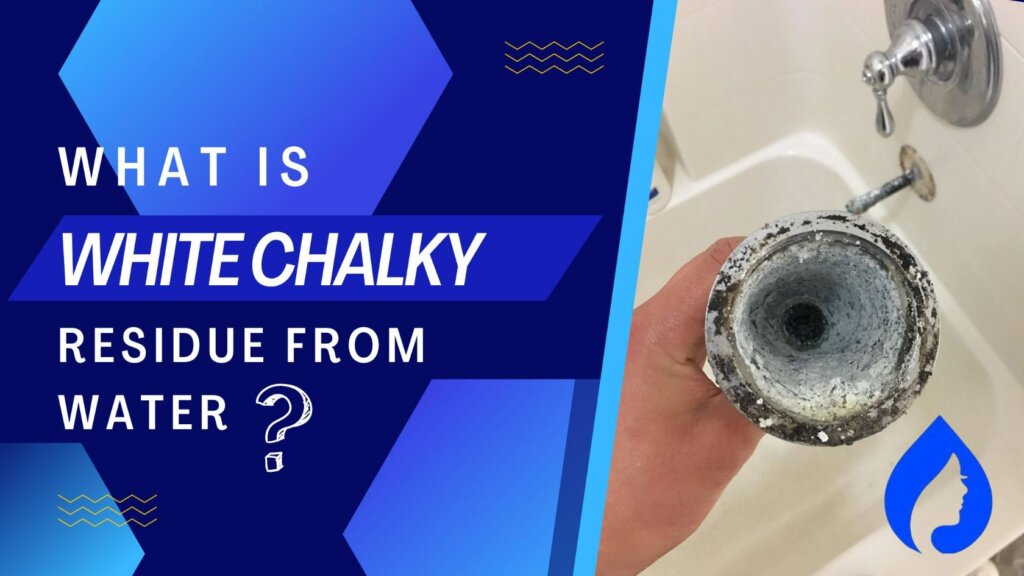
Noticing white chalky residue from water on your bathroom or kitchen faucets?
Here’s the truth:
The white chalky residue you are worried about is limescale buildup caused by high concentrations of hard water mineral deposits, mostly calcium.
This calcium buildup is not harmful to health. Still, it can cause various hard water problems:
Continue reading for a detailed guide on short-term and long-term solutions to deal with limescale in water.
🤔Is It Safe to Drink Water With White Residue?

At the Geneva Conference, WHO (World Health Organization) informed that water hardness has no adverse health effect on human beings.
On the contrary, hard water comprises numerous healthy minerals apart from calcium and magnesium ions that are good for your body. Also, some studies suggest that hard water can protect us from cardiovascular ailment though the results aren’t conclusive yet.
However, the minerals present in hard water, mostly calcium, can create hard water stains in laundry and choke the plumbing fixtures, as revealed below:
👉What Problems Can Limescale Cause?
Limescale (the “white residue” in water caused by medium to a high concentration of both calcium and magnesium residues) though harmless to your health, may cause the following problems:
Also Read: Best Softener For Hard Water In Apartment
🎯How Do You Remove White Residue From Water?

Here are the steps to remove calcium or the white hard water stains from the surface of your different home water appliances or tap water fixtures:
🪙How Do You Get the White Residue off Stainless Steel?
⚪How to Get White Stuff off the Shower Heads?
Also Read: How To Remove Pink Bacteria From Bathroom
💧How to Get White Buildup off the Faucet?

🚽How Do You Remove Encrusted Limescale From a Toilet?
🗑️How to Remove Hard Water Buildup From the Washing Machines?

The steps above can only give you a temporary solution to the hard tap water mineral deposits.
However, to get a permanent solution to the problem of the chalky white substance buildup, you have to:
ion exchange softener installation is the most effective method for removing the limescale buildup. However, some other techniques that also work by converting the hard water into soft water are:
Also Read: Best Faucet For Hard Water
💡White Chalky Residue From Water FAQs
Why Does My Water Leave White Residue?
Limescale is caused by hard water minerals like Ca2+ and Mg2+ (calcium and magnesium), which react with the water to form calcium carbonate or limescale. Limescale is a natural mineral on the earth’s surface and generally occurs in moderately hard water with at least 61-120 mg/L of CaCO3 (calcium carbonate).
If the water is harder than that, then the quantity of lime scale also increases.
It appears as white chalky residue and builds up inside water appliances where hard water has flowed.
Why am I getting water spots with a water softener?
You can get water spots with water softener if-
1. Incorrect salt is used.
2. Salt bridging (a solid salty layer over the salt pile close to the brine tank) happens. It generates a gap and prevents the melting of salt within the water.
3. Salt mushing (the recrystallization of dissolved salt and the formation of soft sediment within the brine tank at the bottom) happens. It prevents the adequate regeneration of the water softener.
4. High TDS (Total Dissolved Solids) or a large quantity of calcium (Ca2+) ions and magnesium (mg2+) ions are present in your home water.
5. Your water softener is not maintained regularly.
Why does my well water leave a white residue?
The water of private wells sometimes leaves a white residue because of the hard water mineral deposits, especially calcium, and magnesium. This residue is chalky and occurs when the minerals come in contact with fixtures and fittings.
What is that white stuff floating in the water after boiling?
That white stuff is the white precipitation of calcium carbonate or limescale (calcium and magnesium remnants) that occurs when hard water is heated or kept at a standstill. It is harmless, and there’s nothing to bother about.
Can water filters remove limescale?
Yes, water filters like the reverse osmosis system (92-98%) and ultrafiltration (50%) can remove limescale by pressurizing the calcium and magnesium leftovers (calcium carbonate deposits) into a semi-permeable membrane.
However, they require pre-treatment as hard minerals like calcium and magnesium damage the RO filters. Therefore, water softeners are the best choice for removing limescale.
Adarsh is a Health & Nutrition Sciences graduate with expertise in environmental health. He is associated with ventures like Glacier Fresh Filter and Simpure Filter Systems. Through Aqua Professor, he intends to provide helpful information to every home to help them make smarter decisions.

I have a problem with my water. I had a water softener fitted as I had a new bathroom and wanted to protect it from limescale. The water is now soft, but I’m getting this residue.This is a photo of my shower screen after one shower. I do not know what it is. I have had the softener supplier out and they are blaming the water supply, I’ve been in touch with Thames Water and they say that it’s the water softener causing it. What do I do?
Hi Andrew, sorry to hear about your problem. Your water can have high TDS (Total dissolved solids).
You may need a whole-house water filter. It’s best to consult a plumber for a personalized solution.